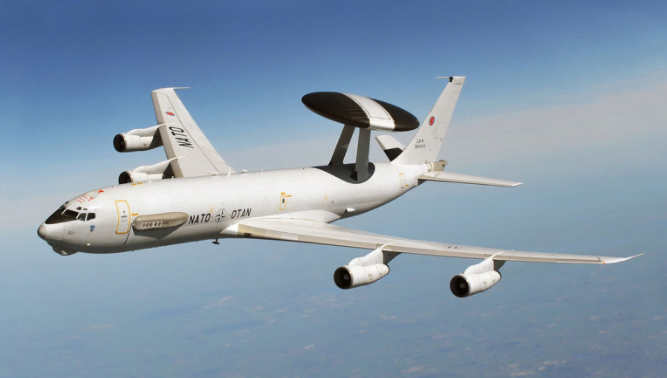Follow Us:

Share
Defense Feeds – Aircrafts may usually get to monitor targets faster than ground personnel, they can encompass more territory in a flyby or loiter on location, and they provide a different bird’s-eye view to ground observers.
Additionally, they can observe the conflicted areas while remaining at the safest distance to avoid severe consequences. But then the question arises, who can specifically perform these tasks?

Who can control where are the armed combatants located, what are the conditions of the conflicted areas and how the peacekeepers can travel to the targeted sites?
The answer to these pertinent questions can of course be greatly aided by aerial reconnaissance of those so-called the NATO’s eyes in the sky!
Hello everyone, welcome back again with us on forcesproject.com. In today’s session, we are going to take deep look at the most important part of NATO’s E-3A AWACS! If you are curious about this, let’s discuss in the article below!
As we already known that NATO constitutes to safeguard the freedom and guarantee the security of all its members by military and political means. This is what it defines by collective defence for the purpose of building solidarity and cohesion among its participating nations.
To serve this mission, NATO operates a fleet of Boeing E-3A, different from others, this aircraft is equipped with the Airborne Warning and Control System (AWACS) that is a long-range radar domes installed on the fuselage providing air surveillance, control and communications for the Allies.

So, what is actually the function of this radar and how it works?
The term “radar” refers to “Radio Detection And Ranging” with a purpose of identifying the presence of an object and determining its position. Radar systems can detect not just airborne targets, but also maritime vessels in locations like the North Sea and the Mediterranean Sea.
Operators can identify and monitor enemy aircraft flying at low altitudes over a variety of terrain, as well as provide directions to friendly aircraft flying in the same area. Moreover, with the bird’s-eye view, this aircraft could provide faster coverage, a longer line of sight, and a wider observation area.
Interestingly, the radar coverage of an E-3A flying at 9,150 meters equal to 30,000 feet is 312,000 square kilometres. It means that three E-3As in overlapping orbits can cover all of Central Europe with complete radar coverage. With air-to-air refuelling capability, therefore, the aircraft may perform longer operations.
In regard to how this aircraft operated, the E-3A consists of three surveillance operators to ensure that it obtains an accurate image of what is going on in the operational sites. This image is then sent to ground-based force commanders as well as airborne Allies operating with the E-3A.
By clearly identifying the kind of aircraft, ship, or land installation, the passive detection controller is responsible for the operation of the on-board ESM System, which contributes to the overall situational awareness and threat warning capabilities. This information is disseminated inside the crew as well as to outside agencies to assist to an overall Electronic Order of Battle.
As an additional information, there are some other aircrafts also equipped with the Airborne early warning and control in the current operational list, they are including, first, the US Air Force Boeing E-3 Sentry. Second, the Mexican Air Force Embraer EMB-145. Third, the Indian Air Force Beriev A-50 EL/W-2090.
Fourth, the Saab 2000 Erieye built for the Pakistan Air Force, and the last one, Boeing E-767 of the Japanese Air Self-Defense Force, this is just to name a few!
To conclude, the component of this aircraft has provided tremendous magnifying effects and control capacities to the Alliance. There have been many requests of NATO AWACS surveillances to protect the safety of the skies over NATO summits such as in the United States after 9/11, Libya, and Afghanistan as well as Turkey for the assistance due to the threats posed by the war in Iraq.
Additionally, it performed air assistance for humanitarian efforts in Pakistan after the devastating earthquake, and to victims of 2005-Hurricane Katrina in New Orleans, Louisiana, and of course some others critical air surveillance to maintain any possible attacks to its allies.
Share
Defense Feeds is publication focusing on informing, engaging, and empowering the world by providing accurate information from defense technology.
Powered by Defense Feeds © 2025 – All rights reserved.